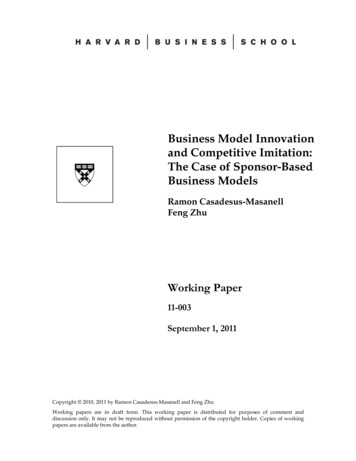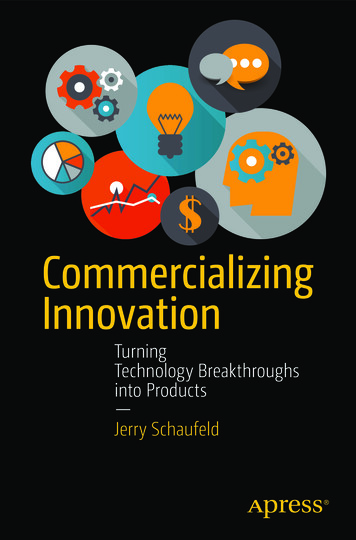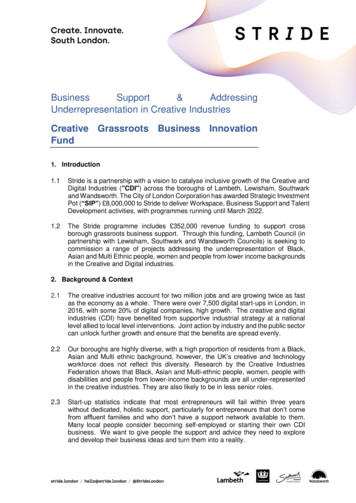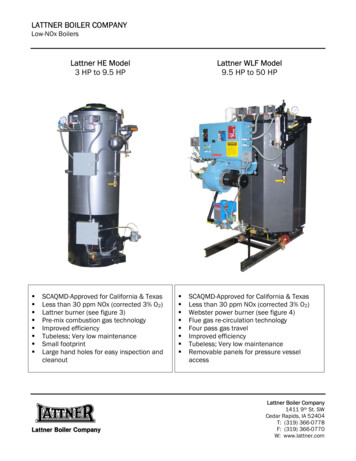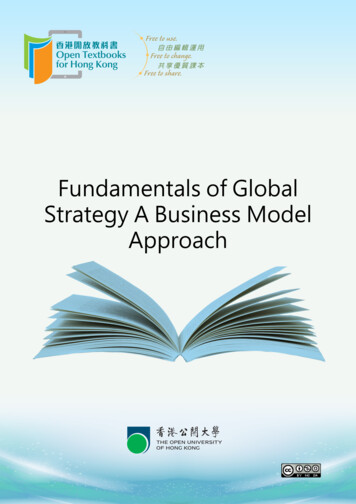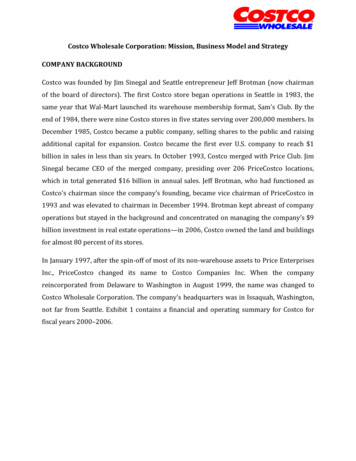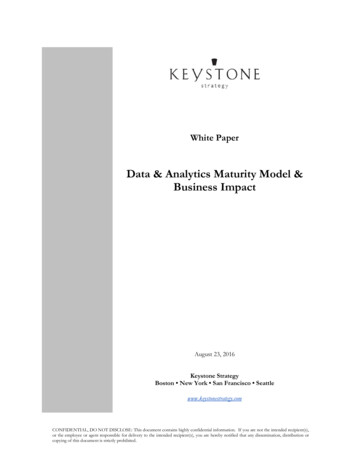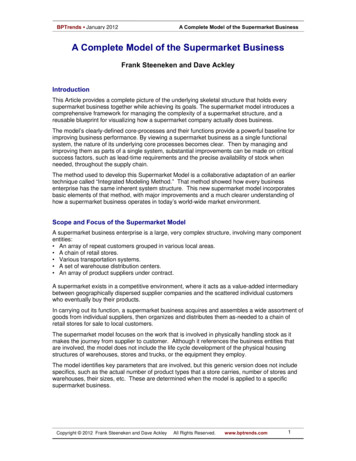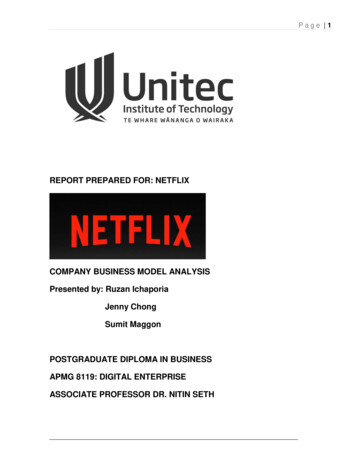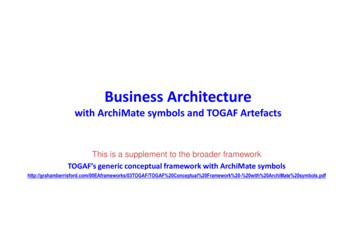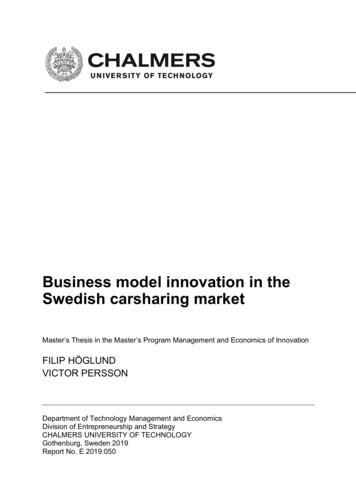
Transcription
Business model innovation in theSwedish carsharing marketA qualitative studyMaster’s Thesis in the Master’s Program Management and Economics of InnovationFILIP HÖGLUNDVICTOR PERSSONDepartment of Technology Management and EconomicsDivision of Entrepreneurship and StrategyCHALMERS UNIVERSITY OF TECHNOLOGYGothenburg, Sweden 2019Report No. E 2019:050
2
MASTER’S THESIS E 2019:050Business model innovation in the Swedishcarsharing marketA qualitative studyFILIP HÖGLUNDVICTOR PERSSONTutor, Chalmers: Giada BaldessarelliTutor, Volvo: Burcu HillerströmDepartment of Technology Management and EconomicsDivision of Entrepreneurship and StrategyCHALMERS UNIVERSITY OF TECHNOLOGYGothenburg, Sweden 20193
Business model innovation in the Swedish carsharing marketSubtitleFILIP HÖGLUNDVICTOR PERSSON FILIP HÖGLUND. VICTOR PERSSON, 2019.Master’s Thesis E 2019:050Department of Technology Management and EconomicsDivision of Entrepreneurship and StrategyChalmers University of TechnologySE-412 96 Gothenburg, SwedenTelephone: 46 (0)31-772 1000Chalmers digitaltryckGothenburg, Sweden 20194
AbstractThe concept of mobility is entering a new era. This is exemplified by changing customerpreferences, new modes of mobility and new business models. This paradigmatic shift hasforced OEMs to transform beyond car manufacturers into the role of mobility providerswhere carsharing is a concept with high predicted future growth. Therefore, this thesis aims toanswer how an OEM can innovate its station-based carsharing business model in order toimprove its business-to-consumer offering in the Swedish carsharing market.The theoretical framework focuses on literature covering the concept of business models aswell as business model innovation. More specifically, the concept of how business modelinnovation is defined, how it is conducted and why it is relevant is described and elaboratedon from the perspective of multiple scholars. The study has applied a qualitative researchstrategy with the use of both primary and secondary data. The primary data consisted of semistructured interviews where customers, non-customers, researchers and market players wereinterviewed. The interviews were coded and clustered into distinct themes which served as themain categories in the empirical findings. Moreover, the main secondary data consisted ofinformation from website in order to map the current market players and their business modelcharacteristics.The empirical findings highlighted four categories of customer pains in relation to the currentofferings, namely lack of flexibility, trips resulting in paying for non-usage, poor fit for multimodality and a market structured in silos. In combination with the mapping of the marketplayer, it could be determined that these pains constituted a void area in the market where nocurrent market player offered a high pick-up and drop-off flexibility. Moreover, seeing as themajority of pains were related to station-based carsharing, a potential for addressing thesepains were found to be to offer one-way trips within such a concept. Furthermore, four mainareas of challenges that might arise if these customer pains were to be addressed were found.These were associated with the risk of asymmetric flows, the increased cost with carrelocation, critical mass of customers, and sustainability aspects.By using the insights gathered from the empirical finds in conjunction with theory on businessmodel innovation, several business model patterns suited to address both the customer painsand the challenges that might arise from addressing those pains were found. More specifically,by employing the do more to address the job and the solution provider pattern, a basis for a new valueproposition for was created characterized by extending station-based carsharing to includeone-way trips. Moreover, by employing the self-service and the freemium pattern, the challengesof such a value proposition could be addressed. Thus, this study finds that if an OEM with astation-based carsharing offering would adopt these four business model patterns, this has thepossibility to improve its business-to-consumer carsharing offering as well as constitutebusiness model innovation as described in theory.5
6
Table of contents1 Introduction . 11.1 Background. 11.2 Aim . 31.3 Research question . 31.4 Delimitations . 41.5 Limitations . 42 Theoretical framework . 52.1 The current state of the business model research . 52.2 The business model as a theoretical concept . 62.3 Business model canvas . 82.4 The value proposition canvas . 112.5 Business model innovation . 122.5.1 What it is . 122.5.2 Why it is relevant. 132.5.3 How it is done . 142.5.4 Business model patterns . 162.5.5 Business model innovation in the automotive industry . 172.5.6 Challenges associated with business model innovation . 182.6 Customer needs as a trigger for business model innovation . 182.7 Overview of carsharing and car-rental . 192.7.1 Carsharing . 192.7.2 Car-rental . 212.8 Research learnings about customer mobility needs . 212.8.1 Learnings from the UbiGo field trial . 222.8.2 Different travel needs call for different vehicle attributes . 243 Methodology . 253.1 Research process description . 253.2 Research strategy . 273.2 Literature study . 273.4 Data collection . 273.4.1 Primary data . 283.4.2 Secondary data . 313.5 Data analysis. 313.5.1 Primary data . 313.5.2 Secondary data . 323.6 Research quality . 324 Empirical findings . 344.1 Market players and their value propositions . 344.1.1 Aimo . 347
4.1.2 Sunfleet . 354.1.3 Move About . 364.1.4 Zipcar . 374.1.5 Hertz . 384.2 Customer pains in relation to the current offerings . 394.2.1 Lack of flexibility . 394.2.2 Trips resulting in paying for non-usage . 434.2.3 Poor fit for multi-modality . 474.2.4 Market structured in silos . 484.3 The relation between the existing value propositions and customer pains . 514.4 Resolving customer pains imposes new business challenges . 574.4.1 The risk of asymmetric flows . 584.4.2 The increased costs with car relocation . 594.4.3 Critical mass of customers is essential . 604.4.4 Sustainability aspects . 624.4.5 Other aspects . 645 Discussion . 675.1 BMI process outline. 675.1.1 What are the current offerings and the associated business model characteristics in the carsharingmarket? . 685.1.2 What are the customer pains in relation to the current offerings and how could those be addressed?715.1.3 What business challenges will potentially arise if station-based offerings are modified to address thosepains and how could those be resolved? . 755.2 How can an OEM innovate its station-based carsharing business model in order to improve its business-to-consumer mobility
answer how an OEM can innovate its station-based carsharing business model in order to improve its business-to-consumer offering in the Swedish carsharing market. The theoretical framework focuses on literature covering the concept of business models as well as business model innovation. More specifically, the concept of how business modelAuthor: Victor Persson, Filip HöglundPublish Year: 2019
